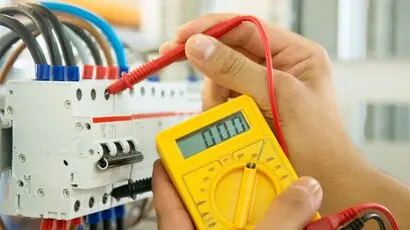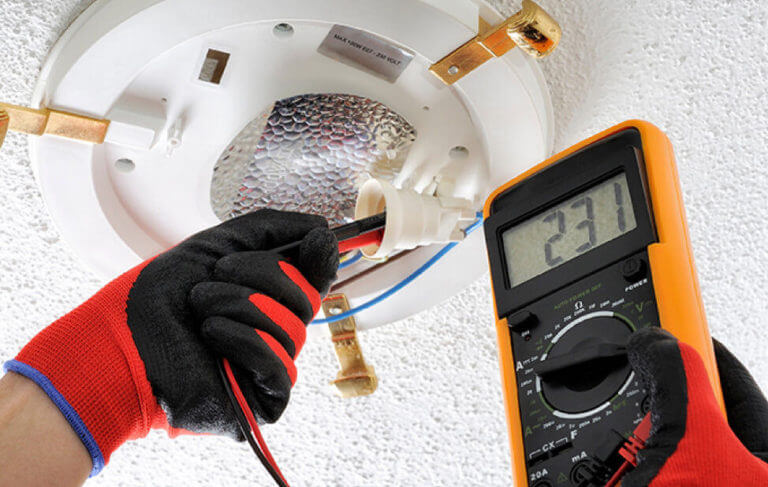Usual Electric Issues Every Property Owner Need To Understand about
Homeowners commonly encounter different electrical problems that can impact safety and performance. Problems like flickering lights and tripped breaker are more typical than several understand. These situations can suggest much deeper electric concerns that warrant attention. Comprehending the indicators and threats linked with out-of-date electrical wiring and dead outlets is vital. What steps can be taken to stop these issues? Exploring these common electric problems can disclose important insights for maintaining a secure home setting.

Flickering Lights: Causes and Solutions
Why do some property owners experience flickering lights? Flickering lights can be a common annoyance, usually indicating underlying electrical problems. One main reason is loosened or malfunctioning connections within light components or wiring, which can lead to intermittent power supply. In addition, using high-wattage appliances on the exact same circuit may create voltage changes, leading to lowering or flickering. An additional potential issue is an overloaded circuit, where way too many devices draw power all at once, stressing the electrical system. Additionally, outdated or abject wiring can add to irregular electric circulation. In some situations, flickering lights might indicate an issue with the home's electric panel or service line. Home owners ought to deal with flickering lights without delay to stay clear of possible threats. Solutions may consist of tightening links, rearranging device load, or speaking with a licensed electrician for a comprehensive assessment. Recognizing the origin reason can assist guarantee a steady and risk-free electric system in the home.
Tripped Circuit Breakers: What You Required to Know
Have property owners ever before wondered what creates their circuit breakers to trip suddenly? This usual concern often arises from an overload of electric circuits, where as well many gadgets attract power concurrently. In such cases, the breaker acts as a safety device, interrupting the flow of electrical power to avoid getting too hot and potential threats. Another frequent reason is a short circuit, which occurs when an online wire get in touches with a neutral cable, producing a rise of electricity that trips the breaker. Ground mistakes can additionally result in tripped breakers; these happen when an online cord touches the ground or a based surface, positioning serious safety dangers. House owners should frequently analyze their use of high-wattage devices to prevent straining circuits. Additionally, comprehending the function of breaker can help them react suitably throughout a trip, ensuring their home stays well-maintained and risk-free.
Out-of-date Circuitry: Risks and signs
Outdated electrical wiring can position significant dangers to homeowners, commonly going undetected till problems arise. Homes built before the 1980s might still have light weight aluminum circuitry or knob-and-tube systems, which are no much longer taken into consideration secure. Signs of out-of-date circuitry include flickering lights, frequently tripped breaker, or shedding smells near outlets. These signs may recommend that the electrical system is overloaded or deteriorating.Additionally, home owners might discover blister marks around switches or outlets, which can show getting too hot. The threat of electrical fires significantly boosts with out-of-date electrical wiring, as these systems were not designed to manage modern-day electric lots. Home owners are encouraged to have their wiring evaluated regularly, specifically when remodeling or including brand-new appliances. By identifying these indications early, they can avoid harmful situations and keep a safer living setting. Updating to current electric requirements is an aggressive step in keeping home safety and efficiency.
Frequently Blown Fuses: Repairing Tips
Frequent blown fuses can show underlying electrical concerns that may stem from outdated wiring or overloaded circuits. House owners experiencing this trouble should initially identify the home appliances connected to the impacted circuit. It is advisable to prevent using numerous high-wattage devices at the same time, as this can bring about circuit overload. If the trouble persists, evaluating the fuse box for indicators of wear or damage is critical; a defective circuit box may need replacement.Additionally, examining for loose connections within the circuit can assist protect against future incidents. Homeowners ought to additionally validate that the merges being made use of are of the correct amperage, as utilizing a wrong fuse can aggravate the problem. If these fixing ideas do not solve the concern, speaking with an accredited electrician is recommended to assess the electrical system additionally. Dealing with these issues without delay can aid mitigate dangers and assure the safety and security of the home's electric framework.
Dead Electrical Outlets: Usual Causes and Fixes
When a property owner experiences a dead outlet, it can typically be a source of stress and complication. Several typical reasons might result in this concern. One regular offender is a tripped circuit breaker, which can be quickly reset. Property owners should inspect their electrical panel to check if any breakers are in the off position. One more possibility is a defective outlet itself, which may call for substitute. Furthermore, loose wiring links within the outlet can interfere with power flow, making examination essential.Sometimes, the trouble may originate from an overloaded circuit, particularly when several tools are attached. In such cases, redistributing the electrical lots can fix the issue. Homeowners should likewise consider the age of their electrical wiring; older systems might require updates to satisfy contemporary electrical needs. If these actions do not rectify the situation, getting in touch with an accredited electrical expert is recommended to ensure security and appropriate diagnosis.
Electric Shocks: When to Be Concerned
Exactly how can house owners identify whether an electric shock warrants concern? Property owners need to initially evaluate the intensity and context of the shock. A light static shock, commonly felt when touching metal objects, is normally harmless and typical. However, if the shock takes place while engaging with a plugged-in home appliance or outlet, it might suggest a more serious issue.The area and frequency of the shocks are crucial. Repeated shocks from the exact same source, especially in wet areas like bathrooms or kitchen areas, might indicate malfunctioning circuitry or insufficient grounding. House owners must likewise think about the experience of the shock; a shock that causes pain or muscle mass contractions is extra startling than a simple tingle.If there's any type of uncertainty, it is a good idea to get in touch with a qualified electrical expert. Overlooking prospective electric dangers can lead to serious safety and security threats, including fire or severe injury.
Overloaded Circuits: Avoidance and Safety And Security Measures
Overloaded circuits position substantial risks in domestic setups, usually causing electrical fires or equipment damages (Level 2 Electrician). House owners need to acknowledge the indicators of an overloaded circuit, such as often stumbled breakers or dimming lights. Applying precautionary safety and security methods can assist reduce these dangers and guarantee a more secure living atmosphere
Recognizing Overloaded Circuits
What indicators indicate that a circuit may be strained? Home owners need to be attentive for several essential indications. Regularly tripped circuit breakers or blown merges recommend too much load on the circuit. Lowering or flickering lights, specifically when various other appliances remain in use, can indicate an insufficient power supply. Furthermore, electrical outlets or switches that really feel warm to the touch might show getting too hot, a potential fire threat. Unusual humming audios from outlets likewise necessitate attention, as they can indicate electric issues. If appliances operate hop over to here inefficiently or stop working to start, it may be an indicator of an overloaded circuit. Recognizing these signs early can aid stop significant electric troubles and advertise a more secure home setting.
Preventive Safety Practices
To preserve a safe and reliable electric system, home owners must carry out preventive safety practices that deal with potential circuit overloads. One effective procedure is to prevent attaching way too many tools to a single outlet, as this can go beyond the circuit's capability. Making use of power strips with integrated circuit breakers can help distribute power securely. Homeowners ought to additionally consistently evaluate cords and home appliances for damage and change any type of defective devices immediately. It is important to guarantee that browse around these guys circuit breakers are operating properly and to be familiar with the complete power level being used in each circuit. In addition, getting in touch with an accredited electrician for regular assessments can identify potential concerns prior to they escalate, assuring a safer living atmosphere and lengthening the life-span of electrical systems.
Regularly Asked Questions
How Typically Should I Have My Electric System Inspected?
Regular assessments of electrical systems are suggested every three to 5 years. Property owners should consider much more constant checks if they experience issues, carry out improvements, or stay in older residential or commercial properties to assure safety and compliance.
Can I Repair Electric Problems Myself or Employ a Professional?

What Are the Indicators of an Electric Fire Threat?
Indications of an electric fire risk consist of frequently stumbled breaker, flickering lights, shedding smells, discolored outlets, or cozy, humming cords. Property owners ought to remain attentive and seek professional aid if any one of these indications exist.
How Do I Know if My Home Needs an Electrical Upgrade?
To identify if a home needs an electrical upgrade, indications consist of regular breaker journeys, obsolete circuitry, inadequate electrical outlets, flickering lights, and the presence of older electric panels, indicating potential safety and security dangers and inadequacy.
Are There Details Security Tips for Do It Yourself Electric Work?
When considering DIY electric job, one should constantly switch off power, make use of protected tools, verify circuit capability, follow neighborhood codes, and speak with experts for complicated jobs to guarantee safety and security and protect against mishaps. An additional possible problem is an overloaded circuit, where also several devices draw power concurrently, straining the electric system. The risk of electric fires markedly increases with obsolete wiring, as these systems were not designed to deal visit this website with modern electric tons. Frequent blown integrates can indicate underlying electric problems that might stem from outdated circuitry or overloaded circuits. To keep a secure and effective electrical system, house owners should execute preventive security practices that deal with prospective circuit overloads. Level 2 Electrician. Signs of an electrical fire risk include often tripped circuit breakers, flickering lights, melting smells, tarnished electrical outlets, or cozy, buzzing wires